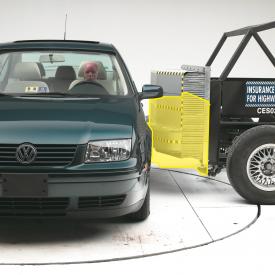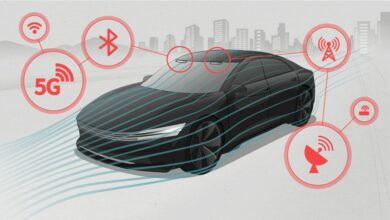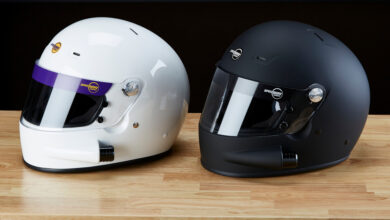IIHS Prepares to Launch New, More Challenging Side Crash Test

After completing a study of its side crash test system, the Insurance Institute for Highway Safety has announced it is launching a new test program with a higher impact speed and a heavier, more realistic movable barrier representing a more modern striking vehicle later this year.
In addition to identifying things that should change, the research also clarified what aspects of the current evaluation work well. Measures collected from the test were found to correlate closely with fatality risk. Thus, the new test will likely use the same dummies and collect similar information as the current one.
“This is an opportunity to build on what we’ve learned in more than 15 years of side testing,” says IIHS Senior Research Engineer Becky Mueller. “We’ll update the things that need updating, but we don’t need to throw out the things that still work well.”
A previous IIHS study looked at side crashes in good-rated vehicles that resulted in deaths or serious injuries. That study showed that many of those crashes were more severe than the IIHS test and also had a more forward impact location.
The severity of a side crash depends on both the weight of the striking vehicle and its speed. The movable barrier currently used in the IIHS side test weighs 3,300 pounds. At the time the test began, many SUVs on the road were close to that weight, but they have gotten much heavier since then.
To better reflect the higher-severity crashes occurring in the real world, Mueller and other IIHS engineers began a series of research tests at a higher speed — 37 mph instead of the 31-mph speed used in the current side rating test. They also made the movable barrier heavier, increasing its weight to nearly 4,200 pounds, the average weight of a 2019 model SUV.
“These changes might not sound like a big deal, but the 6-mph speed increase alone produces 42 percent more crash energy,” Mueller says. “Together with the weight increase, the modified test configuration has 82 percent more energy than our current side rating test.”
IIHS engineers also conducted tests with a more forward impact location on the struck vehicle, but that change didn’t appear to lead to higher injury risk. In fact, the injury measures from the dummies were lower in the forward configuration than in the standard configuration.
The goal of these research tests was to see how well crashes at the higher speed with the heavier barrier resembled crashes using a real SUV or pickup in place of the barrier.
For the initial round, the team selected four good-rated vehicles — a Toyota Camry, Volkswagen Atlas, Honda Accord and Infiniti QX50 — to subject to a variety of impacts. The test vehicles were struck by a popular pickup, SUV and car, as well as by the 4,200-pound movable barrier. Tests were conducted at the current side test speed of 31 mph and also at 37 mph.
The crashes with the movable barrier weren’t identical to the crashes with a second vehicle. Video footage showed that the struck vehicles rolled away from the barrier but toward the striking vehicles.
The structural damage also differed. The frame rails — the stiffest part of a vehicle front — of the striking vehicles punched into the middle of the struck vehicle’s doors, wrapping around the B-pillar.
In contrast, the movable barrier has uniform stiffness and strikes the vehicles more evenly. That means the B-pillar can absorb more of the crash energy in the test than it would in a real-world crash.
The engineers are now experimenting with changes to the barrier’s honeycomb face to try to better replicate the interaction of vehicles in a real-world crash involving a late-model SUV or pickup as the striking vehicle. They are altering the honeycomb shape and varying the stiffness within it, just as it varies on the front of a real SUV.
“Our goal is to create a barrier that creates the same type of damage as a typical late-model SUV or pickup would in a 37 mph crash,” Mueller says. “That way, we can be confident that the changes automakers make in hopes of achieving good ratings in the new side test will result in better protection for vehicle occupants in real-world crashes.”



